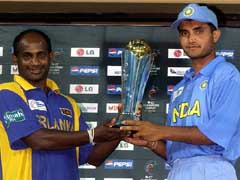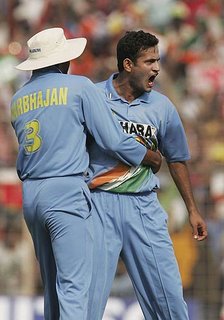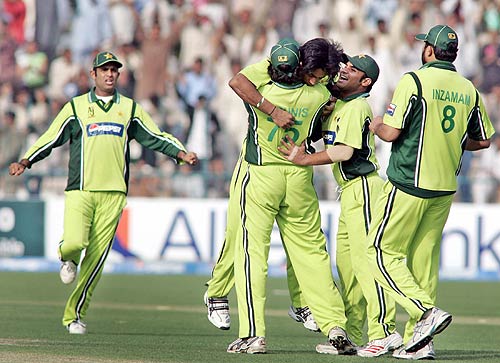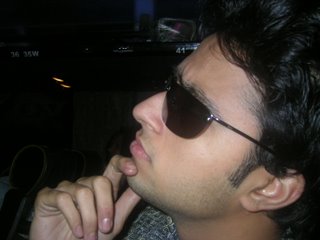 In a few hours - four to be precise - the ICC Champions Trophy will be underway, with hosts India playing England. While both teams will look at this game as a must-win, with tough matches against Australia and the West Indies to come, India will probably be more confident at the outset despite their poor recent one-day form. England return to India on the back of a stirring revival at home but their 5-1 mauling in India earlier in the year must still be fresh in the memory. Since that tremendous series victory, India's fortunes have faltered, losing 4-1 in the West Indies, and then failing to make the final of the DLF Cup in Malaysia - a triangular tournament featuring the other two teams in the group - Australia and the West Indies.
In a few hours - four to be precise - the ICC Champions Trophy will be underway, with hosts India playing England. While both teams will look at this game as a must-win, with tough matches against Australia and the West Indies to come, India will probably be more confident at the outset despite their poor recent one-day form. England return to India on the back of a stirring revival at home but their 5-1 mauling in India earlier in the year must still be fresh in the memory. Since that tremendous series victory, India's fortunes have faltered, losing 4-1 in the West Indies, and then failing to make the final of the DLF Cup in Malaysia - a triangular tournament featuring the other two teams in the group - Australia and the West Indies.
The competition has undergone yet another change in format. What began as a pure knockout competition to whet the public's appetite for the following year's World Cup has rapidly evolved into a parallel World Championship in its own right, with a group stage being introduced in the 2002 edition in Sri Lanka. This was presumably an attempt to cash in further on the success of the 1998 and 2000 tournaments by increasing the number of games played. The change led to the tournament becoming a catalogue of dead, one-sided matches in the opening stages. Each group contained two highly ranked nations, and one that just showed up to make up the numbers. Although it got off to a decent enough start, with South Africa edging the West Indies by two wickets, the rest of the group stage dragged on for another 10 days, with only the India vs England match being of any note, and that too only for Virender Sehwag and Sourav Ganguly's magnificent opening stand of 192 off 28.4 overs. The semi-finals were far more exciting, and the cricket on show was top-notch, but the tournament had lost its earlier sheen, taking far too long to reach its denouement.

The 2004 competition, held in England, was even worse. Inexplicably, the organisers chose to stick with the same format, in spite of its obvious flaws. To compound matters, all the 'dead' matches (Australia vs USA, anyone?) were scheduled for the start of the competition, and the first 'competitive' match - Australia vs New Zealand, took place a full six days after the tournament started. Quite how the ICC planned to maintain spectators' interest through this period is anyone's guess. From that point onwards, the cricket was tense and competitive, and two dark horses - West Indies and England - found themselves in the final. What transpired on that day will forever remain etched in the memories of its protagonists. Finding themselves all but defeated at 147/8 while chasing 218 for victory, tailenders Courtney Browne and Ian Bradshaw rallied to engineer a sensational victory for the West Indies in the fading September light. The victory provided hope for a revival of a once-great team, but subsequent matches would prove that to be a false dawn.
This year, the organisers have once again changed the format, eschewing the bloated twelve team structure for a more practical eight team tournament. The top six Test-playing nations automatically qualified for the group stages while the remaining four played a round-robin qualifying stage, with the top two progressing to the tournament proper. The qualifiers, as expected, were the West Indies and Sri Lanka, who overcame the hardly challenging opposition of Zimbabwe and Bangladesh. At first glance, this format promises to be more exciting than previous attempts. Cutting down the number of groups to two means there will be more games pitting top teams against each other. Each game in the group stage appears to be evenly-balanced, with only the Australia-West Indies pairing offering anything close to a mismatch. Compared to previous years, the race for a semi-final spot will be tighter than ever, and while a straight knockout is probably the ideal format for a tournament such as this, the current structure isn't bad either. And of course, there's the perennial Australia vs England rivalry to look forward to, as well as Australia vs India. Then there's the mouth-watering prospect of an India vs Pakistan or Australia vs New Zealand match in the later stages. All in all, the organisers may have got it right for once. It is now up to the teams to put on a show.
On a personal note, it's great to see Brabourne Stadium reinstated as Bombay's official venue for the duration of the tournament. Bombay cricket should never have moved to the concrete monstrosity that is Wankhede Stadium. Brabourne has a sense of history and grandeur that Wankhede could never have hoped to emulate, and hopefully this move will be a permanent one. Along with Mohali and Eden Gardens, Brabourne ranks up there as one of India's great sporting arenas.

Naturally, Australia enter the tournament with high expectations. The Champions Trophy remains the one competition they have never won, with their best performance being a semi-final appearance in Sri Lanka in 2002. Their one-day record against all three teams in their group indicates that they should go through without too much fuss, though they have never beaten India in this competition, and lost to England in the 2004 edition, although it must be noted that England were playing at home. For all the talk of theirs being an aging side that is over-reliant on the likes of McGrath and Ponting, they are still the best team going around. Their fast bowling is a concern, but the recent emergence of Mitchell Johnson is a good omen for the future of Australian quicks. While they have undeniably been in decline over the last two years, it just means that they have gone from being almost invincible to being beatable on a good day. They may have one eye on the upcoming Ashes series, but should at least progress to the semi-finals, and are good enough to win it for the first time.
England have had a tough time in the one-day arena lately. After losing 3-2 in Pakistan and being hammered 5-1 by India, they appeared to have hit a new low when Sri Lanka travelled to England and smashed them 5-0. In recent times, however, they appear to have regained some of their edge, rallying to draw a home series with an albeit distracted Pakistani side after being 2-0 down. Playing in India is going to be a completely different prospect, however, and that too against teams with the batting prowess of Australia, India and the West Indies. Their pace attack isn't likely to be effective in unhelpful conditions, although their batsmen might help themselves to a few runs on easy batting tracks. England's lack of genuine spin options might be their undoing on subcontinental tracks, and it will take some effort for them to get through this difficult group.

India, as always, begin as the dark horses, in spite of having a massive home advantage. After setting a world record for the most consecutive successful run chases last season - a run which included a 6-1 hammering of Sri Lanka at home, a 2-2 home draw with South Africa, a 4-1 away win over Pakistan and a 5-1 molestation of England at home - they were brought crashing back down to earth by an away defeat to the West Indies by a 4-1 margin at the start of this season. This was followed by a failure to qualify for the final of the DLF Cup in Malaysia, albeit after a narrow defeat to Australia. Of greatest concern was the loss of form of key batsmen, such as Yuvraj Singh and Mahendra Dhoni. Irfan Pathan's sudden downturn in fortunes, both with bat and ball, also affected the team severely. The return of Sachin Tendulkar has provided a huge boost to the team, but the overall combination is still unsettled, especially at the top of the order. Both Virender Sehwag and Rahul Dravid have been tried as openers alongside Tendulkar, with mixed results. The middle order looks good on paper, but is known to collapse when under pressure, which is why a strong opening partnership is vital to India's chances of success. In spite of all their problems, India should be there or thereabouts in the end, as it is telling that most of their recent one-day woes have come away from home. At home, their record is exemplary, and they will take some beating here. Their past performances in this competition (two finals and one semi-final) suggest at least a semi-final spot, and it would be hard to argue with that.

Sri Lanka may not be the greatest travellers, but their recent thrashing of England in England suggests that they may be on the right track. The conditions in India will be very similar to those in Sri Lanka, and the old guard of Jayasuriya, Vaas and Muralitharan should enjoy themselves. Newcomer Upul Tharanga and captain Mahela Jayawardene have been in great form of late, and could be the stars of the tournament. A few of these players will have fond memories of the last major tournament to be held in India - the 1996 World Cup - which Sri Lanka went on to win. The Lankans cannot be written off, and are likely to fancy their chances against New Zealand and South Africa, although Pakistan will be a different prospect altogether. If things go to plan, Sri Lanka should be in the semi-finals.

When listing favourites for a cricket tournament, one team is a virtual ever-present - Pakistan. Blessed with a conveyor belt of supremely talented cricketers, they were often let down by their inability to work as a team, until the arrival of Bob Woolmer as coach. He successfully revived Pakistan's fortunes as a major cricketing force, following their disastrous home defeat to India in 2004. Of course, old habits die hard, and signs of Old Pakistan surface every now and then, most recently in the furore over ball-tampering and captain Inzamam-ul-Haq's suspension, leading vice-captain Younis Khan to first reject and then accept the captaincy for the tournament. This side may not be as blessed as their predecessors, but on their day can dismantle any team. The 2006 Champions Trophy may not be well-timed for them, especially considering the suspension of their captain and top batsman, Inzamam-ul-Haq, and the signs of discontent within the camp. However, Pakistan are nothing if not surprising, and a semi-final place isn't beyond them.

New Zealand are the absolute antithesis of Pakistan - a nation that has produced fewer than ten world-class players in the last three decades, yet manages to consistently punch above its weight. Recently, their fortunes in both Test and one-day matches have dipped as a result of a power struggle between captain and coach. Their players are quite familiar with conditions in India, having played there frequently in the recent past, and that should hold them in good stead. However, looking at their group, there doesn't appear to be much hope for the Black Caps. Unless their players pull off a repeat of their efforts in Kenya 2000, an early exit is on the cards.
One can never discount South Africa or the West Indies. In spite of their dismal loss to Sri Lanka in the qualifying round, the Windies managed to land arguably the easier of the two groups. Their recent record against India is very good, and they also managed to run Australia close in the DLF Cup, so their familiarity with the opponents should give them a chance. They might also back themselves against England, who have been abysmal in the one-day arena. South Africa, on the other hand, will be looking to win the whole competition, although they will have to negotiate a tough group. They have the personnel and experience of Indian conditions, having played there last year, but the only concern will be the ongoing investigations into match-fixing involving Herschelle Gibbs. The last thing the team needs is a distraction, and Gibbs' revelations about past indiscretions by South African players is just that. Even so, they remain a formidable team, capable of beating anyone in their group.
India last hosted a major tournament in 1996 when it co-hosted the World Cup with Pakistan and Sri Lanka. Ten years on, the world's greatest cricketing nations return to whet our appetites for next year's World Cup. Here's hoping for a great show and an Indian victory (screw "fair and balanced" - I'm getting right behind my team!).



No comments:
Post a Comment